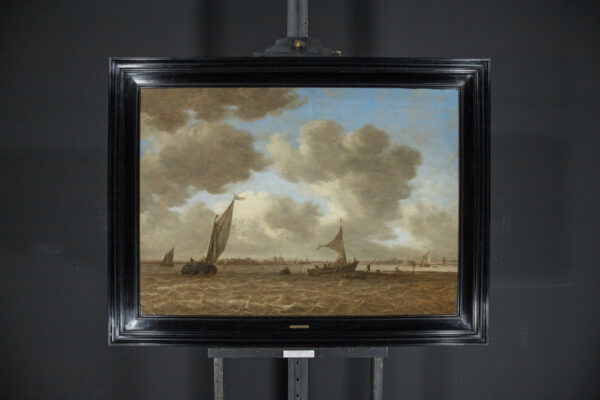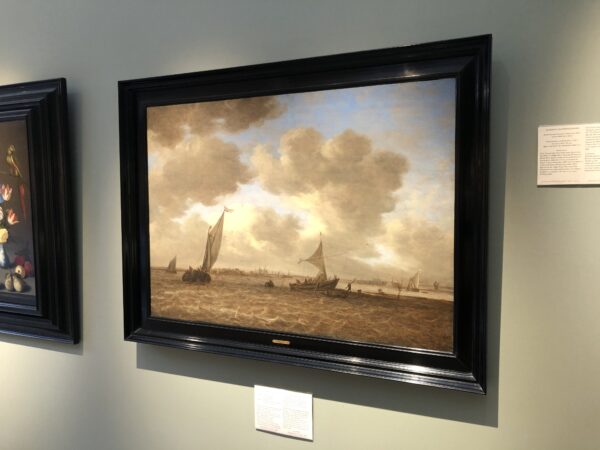“View of a choppy Haarlemmermeer polder, with the contours of the St. Bavo cathedral of Haarlem in the right-hand background”
Oil on panel: 76,5 x 107,5 cm
signed with monogram and dated ‘VG 1648’ (on the boat to the left)
"*" indicates required fields
Notes
This view of the Haarlemmermeer was created in the best period of Jan van Goyen, who was the most prolific landscape painter of the seventeenth century.
In the 1640s he reached the top of his skills by changing from landscape and fairly simple River views to more mature and majestic marines and panoramic views on cities along the major Dutch rivers, such as Dordrecht, Arnhem, Nijmegen, Rhenen.
Especially strong in the present painting is the manner in which atmospheric effects are rendered by Van Goyen; a threatening mass of cloud is coming in from the left, and there is a sense that the winds are rising. The viewer senses the atmosphere, as if he were present.
The right side of the view is still partly sunlit, the last beams are lighting up the choppy waters. The sober use of colour adds to the overall impression of a typical autumn day.
Born on January 13, 1596, Jan Josephsz van Goyen began training as an artist in his native city of Leiden at the early age of ten. The series of teachers with whom he studied included, according to Orlers’ near-contemporary account, Isaac van Swanenburgh (c. 1537–1614). Orlers also says that Van Goyen spent a year in France before going to Haarlem, where he is known to have been a student of Esaias van de Velde I (Dutch, 1587 – 1630) in 1617. His early works closely resemble those of Van de Velde.
By 1618 Van Goyen had returned to Leiden, where that same year he married Annetje Willemsdr van Raelst. His name occurs frequently in Leiden documents between 1625 and 1632. In 1625 he bought a house on the Sint Peterskerkstraat, which he sold in 1629 to the marine painter Jan Porcellis (c. 1584–1632). Probably in the summer of 1632 he moved to The Hague, becoming a citizen two years later. Although he also worked in Haarlem in 1634, at the house of Salomon van Ruysdael’s brother Isaack (1599–1677), he is thereafter recorded only in The Hague. He bought a house there on the Wagenstraat in 1635 and built another the following year on the Dunne Bierkade, where Paulus Potter (Dutch, 1625 – 1654) is known to have lived from 1649 to 1652. Although a prolific and successful painter, Van Goyen engaged throughout his life in various business ventures, usually unsuccessfully; these included art dealing, auction sales, and speculation in real estate and tulip bulbs.
During the 1630s, Van Goyen, along with the Haarlem artists Pieter Molijn (Dutch, 1595 – 1661) and Salomon van Ruysdael (Dutch, c. 1602 – 1670), developed a new approach to the representation of landscape that focused on local subjects and utilized a tonal palette, initiating what has come to be recognized as the golden age of Dutch landscape painting. Van Goyen was a highly respected figure in the artistic community of The Hague. In 1638 and 1640 he was chosen to be hoofdman of the painters’ guild, and received further official recognition in 1651, when he was commissioned to paint a panoramic view of the city for the burgomaster’s room in the Town Hall. In 1649 two of his daughters were married to artists, Margaretha to Jan Steen (Dutch, 1625/1626 – 1679) and Maria to the still-life painter Jacques de Claeuw (c. 1620–1670 or after).
Provenance
- Rev. Thomas Kerrich, England, 1801 (in this year an engraving was made after the painting by Jane C. Hayles);
- collection T. Humphry Ward, London, before 1898;
- in 1898 to Charles Sedelmeyer, art dealer in Paris, catalogue 1899, no. 17, with ill; Collection Max Steinthal, Berlin; Art dealers P. de Boer, Amsterdam; Collection A.C. Fraser, Rotterdam by 1940;
- with David Koetser, Zürich, 1999;
- from whom acquired at TEFAF by the present owner in 1999.
Literature
- Hofstede de Groot, ‘Catalogue raisonné’, 1927, pp. 251-2, no. 1017;
- W. von Bode & Posse, ‘Rembrandt und seine Zeitgenossen’, 1934, with ill.;
- W. von Bode, ‘Die meister der Holländischen und Flämischen Malerschulen’, 1951, n0.217 with ill.
- E. Filla, ‘Jan van Goyen’, 1959, with ill.
- H.U. Beck, ‘Jan van Goyen’, Vol.II, p. 378, no. 845, with ill on p. 377.
Exhibited
- Berlin 1906 ‘Ausstellung von Werken alter Kunst …’, 27 Jan. – 6 March 1906, no. 38, with ill
- idem 1914, no. 47, with ill. (on loan from Max Steinthal)
- Rotterdam 1940, no. 34, with ill., on loan from A.C. Fraser, Rotterdam







